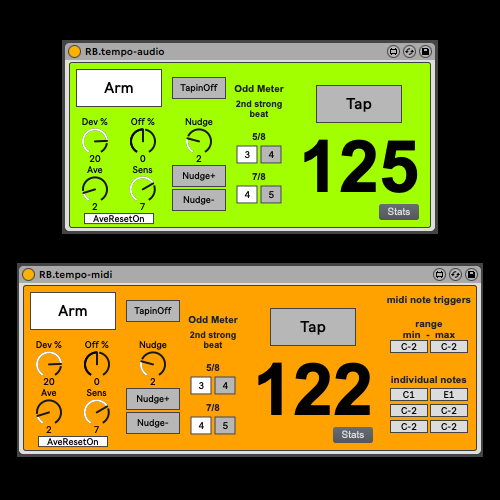Augmenting live performance
Brand new: the SuperDuper Looper plugin - free for feedback! Scroll down for more info…
Brand new: the SuperDuper Looper plugin - free for feedback! Scroll down for more info…
Reactive Backing is a set of Max for Live plugins to augment live musical performance, moving beyond the rigidity of traditional backing tracks.
Since the 1960s recording technology has given us the fixed backing track. Reactive Backing is the long overdue evolution of this technology into a set of plugins that allow a genuinely live musical solution.

Highly customisable tempo following plugins RB.tempo-audio and RB.tempo-midi allow an Ableton Live session to follow the tempo of a musician in a controllable and intuitive way, using any mappable control message or by using MIDI notes themselves.
One beta test-imonial: “The fundamental idea is brilliant. Like with any “real” instrument, some basic training is required – moderate effort (1-2 days)” Dr. Rainer Schlör Bonn, Germany

RB.dynamics takes an incoming average signal level and compares this to a fixed or programmed set of values to vary the dynamics of up to ten other tracks as little or as much as you like.
Combine with the bundled RB.gaindrive plugin (for audio tracks), or the Live MIDI effect Velocity, to lead the dynamics of the whole set. Of course you are not limited to dynamics - you can control pretty much any parameter you like!
This video is my 2016 demonstration of the older version of RB.tempo, the dynamics plugins and the loop plugins - now replaced by RB.4xarrangeloops.

RB.4xarrangeloops supercharges the loop area of the arrangement view, allowing automatic or triggered on-the-fly repositioning of the loop area.
RB.multiverse gives sequential scene launching for the session view, so with a mapped footswitch, or any other MIDI message, four scenes can be stepped through per Switch button.
You can use multiple instances of these plugins on each track meaning that the options are almost infinite…

Yours for app level pricing, countless variations of liveness…
For more information about Reactive Backing, an abridged version of the original academic paper presented at the Innovation in Music conference at Anglia Ruskin University in Cambridge England 2015 is included here.
It gives some background and context, explains ‘relative tap tempo’, (the process that underpins the RB.tempo-audio and RB.tempo-midi devices), and has some interesting information about the psychology of musical synchronisation re. foot tapping.